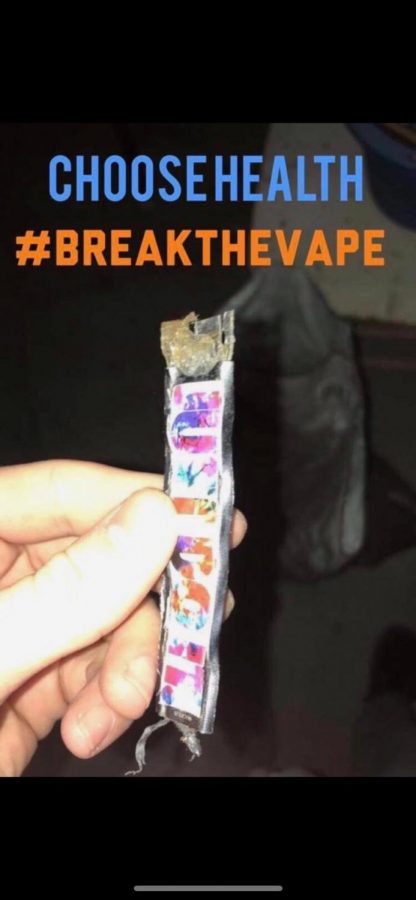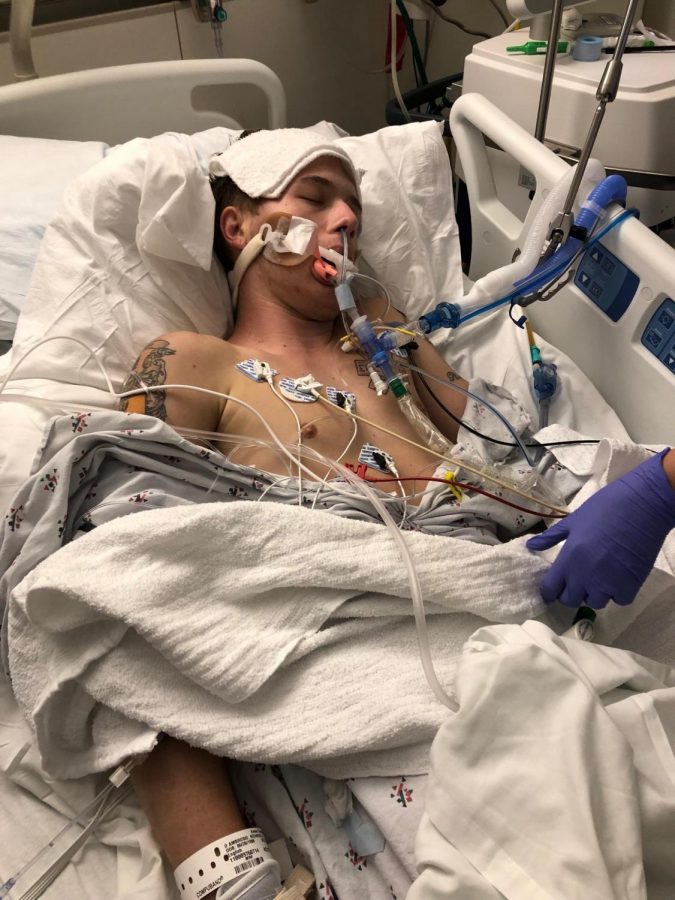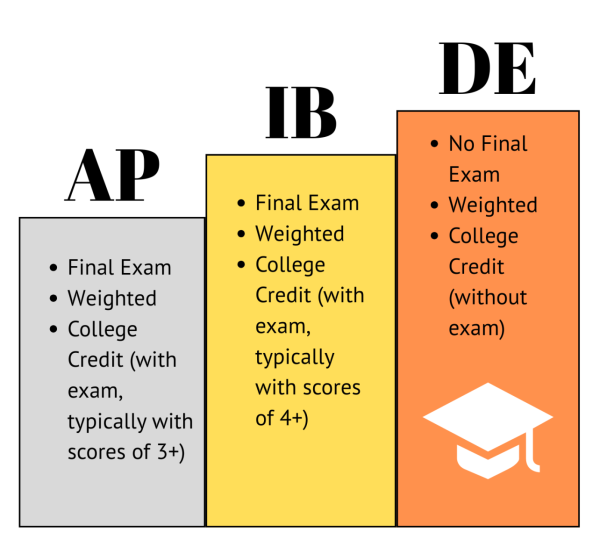Gen Z facing the vaping epidemic
After five days in a coma, a former Rocklin student has become an anti-vaping activist in the Placer County region
Special to GBT.org/CAITY D’AMBROSIO
The result of a five-year nicotine addiction that eventually included vaping, 21-year-old Ricky D’ Ambrosio was rushed to the hospital earlier this year after his flu-like symptoms gradually worsened. Physicians determined D’Ambrosio’s vaping caused his then-critical medical condition.
As vaping becomes a more common and widespread practice, various ramifications are coming to light.
Concerns have already surfaced about the addictive qualities of nicotine, but the most recent and concerning phenomenon has been respiratory failure.
Ricky D’Ambrosio, a 21-year-old Rocklin resident who attended Whitney High, was hospitalized in early September with vaping-related lung trauma. He eventually spent four days in an induced coma.
D’Ambrosio started vaping on-and-off when he was 16.
“It was kind of the new, hip thing in high school,” D’Ambrosio said. “My buddies had the Juul, and I kind of liked the nicotine high at first, but after a while, it just became a habit.”
When vaping was still new to the market, and Americans were still uncertain about the benefits or drawbacks, D’Ambrosio’s high school hadn’t yet established a protocol regarding vaping.
“Teens were able to go into the bathroom (to vape),” D’Ambrosio said. “Some teens even hid it so well as to hide it in their sweatshirt and vape in class and just hold it in until there was no smoke.”
Vaping is quite common today among students at Granite Bay High.
“I think vaping might be a common practice at our school because some kids are addicted (to vaping) and feel like they have to (vape at school),” said Amanda Moorehouse, a senior at GBHS.
D’Ambrosio agrees that vaping is an issue that won’t go away anytime soon.
“I have friends with siblings that are seniors in high school and they say (vaping is) just everywhere,” D’Ambrosio said. “(Teenagers) can (purchase a Juul) anywhere. (They) can go online and it ships it straight to their house.”
However, D’Ambrosio made his own efforts to quit his habit of vaping when he graduated from high school.
“(I) kind of quit (vaping) at the end of high school (and stopped) for a year,” D’Ambrosio said. “(I) started vaping only the Juul when I was 19, turning 20.”
For the last year, D’Ambrosio had been vaping only Juul products.
D’Ambrosio’s health problems first began with a fever and flu-like symptoms.
“(I) wasn’t really eating (and I) was having colds and hot-sweats from the fever,” D’Ambrosio said. “Then, I started vomiting. Because I’m a Type 1 diabetic, when I start throwing up, I immediately go to the hospital (due to) diabetic ketoacidosis which … needs medical attention.”
D’Ambrosio’s doctors took chest X-rays, which were clear at first. However, 36 hours later, the doctor did a follow-up X-ray that showed his lungs were cloudy.
Peter Le, a Southern California pulmonary physician and lung specialist, says cloudy X-rays are the result of lung damage, something Le had seen before in he diagnosed with respiratory failure because of vaping.
“We put a camera down her nose and then into her lung,” Le said. “We saw something called lipid-laden macrophages. Macrophages are like the defense white blood cell … in charge of the immune response.”
The woman’s macrophages had been filled with lipids, or fats, due to the CBD oil of vaping devices. She had inhaled those oils into her lungs.
“When someone comes in … short of breath, we do an x-ray and then a CT scan,” Le said. “What (we) see on imaging is an inflamed lung. When the lung tissue is injured, it swells and … gets leaky.”
Because of the swelling, a person’s lungs are unable to absorb oxygen and release carbon dioxide.
D’Ambrosio’s inability to breathe caused him doctors to decide to put him into an induced coma. His family and friends wondered if he would live.
“They flew my sister up from Arizona because they didn’t really know if I was going to (die) or not,” D’Ambrosio said. “A lot of my friends from SoCal came up to say goodbye.”
D’Ambrosio’s sister, Caity D’Ambrosio, said the experience was tough on her whole family.
“We weren’t sure what was going to happen,” Caity said. “It’s kind of hard to describe watching and wondering if your loved one was going to die.”
Once Ricky came out of the induced coma, he faced many additional challenges.
“The (week) after I was brought out (of the hospital), the withdrawals were hard from the paralytics they gave me,” he said. “They were giving me fentanyl and dilaudid, which are two very strong painkillers.”
A side-effect for one of the drugs they gave him was an inability to sleep.
“I didn’t get any sleep for three days straight,” D’Ambrosio said. “They had to prescribe me something else to get some sleep.”
He found it hard to get sleep in a hospital during constant Code Blue and patients rushing in and out. However, it was also extremely tough when they removed the oxygen tube and D’Ambrosio had to breathe on his own.
“When you’re laying in that bed relying on oxygen, you feel good, but once you stand up, your whole world changes,” D’Ambrosio said. “When I got home, I had shortness of breath for a week. It was really hard to get around the house because I lost 30 pounds in the hospital.”
Caity said Ricky will continue to face challenges.
“He, going forward, has a long road to recovery,” Caity said. “Just imagine that his lungs right now are the lungs of an infant. He doesn’t even have the lung capacity to walk up the stairs right now.”
However, Ricky remains positive about his circumstances and both he and Caity see this experience as an opportunity to raise awareness about the dangers of vaping.

#BREAKTHEVAPE, is the tag that Caity D’Ambrosio started to spread awareness and to prompt action on the topic of banning flavored vapes.
“We did a huge campaign to try to get other students to stop,” Caity said. “I started a hashtag. It’s #breakthevape. (It’s about) breaking the habit (of vaping), so there’s meaning behind it.”
Already, people have sent Caity videos with her hashtag and posted them on social media.
Caity has begun this effort in order to prevent others from going through the extreme circumstances that her brother did.
“I would tell (people who want to vape) to look at my brother’s picture,” Caity said. “I … think that if his picture got out more, and if kids realize that as a possible outcome, (it would be) a big factor in getting kids to stop.”
Meanwhile, Ricky has sought to spread awareness through interviews.
“I’ve promoted (my story through doing) a number of interviews with different people – ABC 10, CBS 13 (and) USA Today,” D’Ambrosio said. “I’m (also) speaking at a few high schools. The main thing I want (teenagers) to know is (that vaping) isn’t worth it.”
Caity has concerns about the way vaping companies market these devices to young people.
“One of the things to stop is all the flavors that go into these devices,” Caity said. “Just having a menthol would be better than having all these gummy bear (and) Starburst flavors.”
Ricky said he believes he was even misled by marketing because when he first started vaping, it was marketed as a safer alternative to smoking cigarettes – something he genuinely believed.
Although nicotine is addictive, Ricky’s friends have made efforts to quit by replicating the whole hand-to-mouth motion.
“A lot of (my friends) keep suckers in their car or they chew gum now whenever they have a craving,” Ricky said. “Some of them even eat Goldfish (crackers) for fun, because it’s that constant little hand-to-mouth motion.”
Le, the pulmonary specialist, said the reportage of vaping’s health-related consequences only encompass the extreme cases. But the danger of lower-level damage is much more widespread and prevalent.
“The injury may not be (severe enough) to cause respiratory failure,” Le said. “(In those cases), we don’t do the workup because putting a camera down into the lungs … is a big deal … if the patient is not that sick. I suspect that the numbers (of vaping-related illnesses) … reported are much lower than what’s really going on. I’m sure all the people that have mild lung injury don’t even know (they are injured).”
Le said there’s a real danger linked to the ambiguity of the chemicals in vaping devices.
“No medical people have tested (the vaping chemicals). Maybe (companies) have tested it, but they don’t release that information,” Le said. “That’s why it’s so dangerous.”
Ashley is a senior, and this is her fourth year on the Gazette staff.
















Ale vezzali • May 6, 2021 at 2:28 pm
My daughter goes to granite oaks and has been vaping since we moved . I would love if she could hear your story so she know maybe the rest consequences of the vape. Thank you!